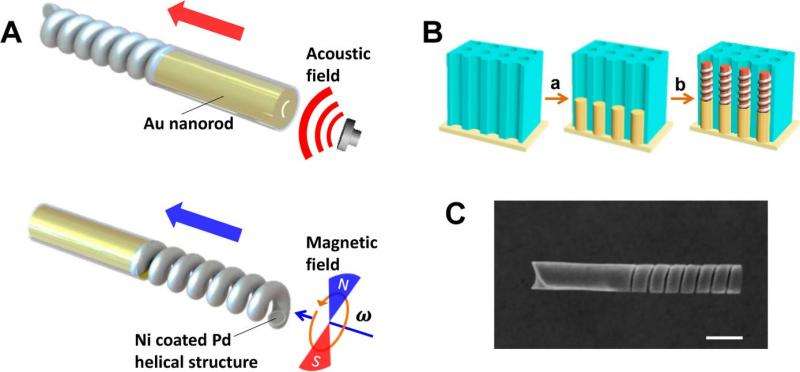June 26, 2015 feature
Fuel-free nanomotor is powered by ultrasound and magnetic fields

(Phys.org)—Nanoscale motors, like their macroscale counterparts, can be built to run on a variety of chemical fuels, such as hydrogen peroxide and others. But unlike macroscale motors, some nanomotors can also run without fuel, instead being powered by either magnetic or acoustic fields. In a new paper, researchers for the first time have demonstrated a nanomotor that can run on both magnetic and acoustic fields, making it the first magneto-acoustic hybrid fuel-free nanomotor.
The researchers, led by Professor Joseph Wang at the University of California, San Diego, have published a paper on the new class of nanomotors in a recent issue of Nano Letters. As magnetic and acoustic fields are biocompatible and commonly used in medicine, the fuel-free nanomotors could be especially useful for biomedical applications.
The nanomotor can respond to both types of fields due to its bisegmented design: the gold nanorod segment responds to ultrasound, and the nanohelical magnetic segment responds to magnetic fields. The entire device is approximately 3000 nm (3 µm) long.
As the researchers explain, using different fields to power a single device offers the potential for rapid reconfiguration of the device's operation. For example, switching between the two different fields rapidly changes the direction of motion because the fields act on opposite ends of the device. In addition, tuning the amplitude of the ultrasound waves or the frequency of the magnetic field enables rapid speed regulation, while applying a rotational magnetic field induces a torque that results in corkscrew motion.
Using fields instead of fuel for power also gives the nanomotor the advantage of being able to operate in highly ionic environments, such as seawater and blood. These media typically interfere with the propulsion mechanisms of chemically powered nanomotors, which often rely on the electric-field-induced motion of electrophoresis.
When several of the new nanomotors are placed in close proximity, the researchers found that they exhibit swarming behavior similar to the collective behavior seen in some biological systems, such as schools of fish. The researchers observed three different states of switchable collective behavior, depending on the applied field: stable aggregation with ultrasound only, directional swarm motion with magnetic fields only, and a swirling swarm vortex with both fields.
In the future, the broad scope of operations offered by the magnetic and acoustic actuations could lead to an even more intriguing possibility: smart nanovehicles that autonomously reconfigure themselves in response to changes in the environment or their own performance in order to achieve a predetermined mission. This ability could prove especially useful for biomedical applications, such as imaging, drug delivery, and diagnosis. Other applications may include nanoscale manipulation and assembly in the wider field of artificial nanomachines.
More information: Jinxing Li, et al. "Magneto-Acoustic Hybrid Nanomotor." Nano Letters. DOI: 10.1021/acs.nanolett.5b01945
Journal information: Nano Letters
© 2015 Phys.org




















